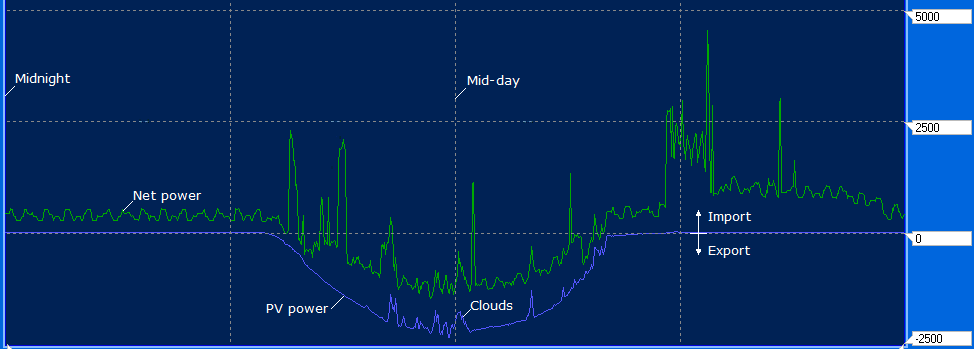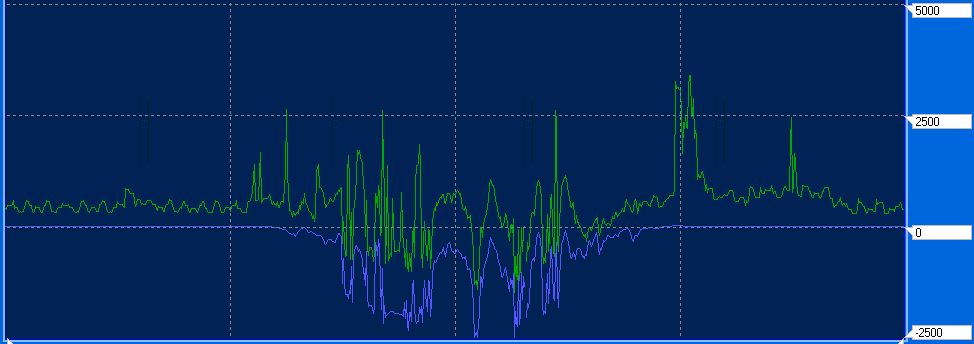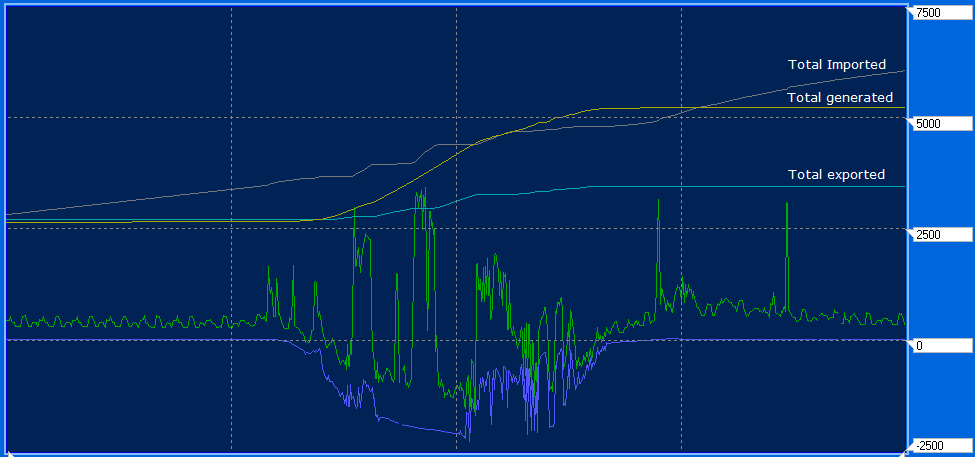The way to look at whether to get solar PV - given that you aren't trying to go off grid - is purely financial. How much money on my power bill am I going to save and how much is it going to cost me up front? Don't be emotional about it. If you are going to be living in your house for longer than the payback time (including interest) then do it.
Definitions: Photo Voltaic (PV) cells generate electrical energy from the sun. The more you have, the more energy you can make. PV generates Direct Current (DC) power, which is converted by an inverter into Alternating Current (AC) at the distribution frequency (50Hz in Australia). When the inverter synchronises its output to the power companies (grid) frequency, power from the sun is powering your home, and maybe exporting power out to the grid too!
Fun facts: on the DC side the inverter constantly checks and presents the optimal load to the PV cells for maximum efficiency; on the AC side the inverter creates a sine wave attempting to increase the grid AC frequency, essentially putting energy into your home or out to the grid if your home load is not high enough. Unloaded the inverter frequency would race up, typically tripping out if the frequency is more than 2Hz higher than expected.
In Australia you pay (AUD2016)$0.25 to buy a kWh, and the power company will pay you $0.08 to buy a kWh for you. So you want to use the energy you are producing, not sell it. It hasn't always been this way, in the past the government had incentive schemes with generous energy buybacks, but that's not how it is now. You need to think that PV is to reduce the amount of energy you have to buy, not to try and sell energy to the power company.
With that in mind, the ideal is that you PV is sized to produce the exact amount of power you need while the sun is shining, no more, no less.
Here is a "typical" plot of power production from my 3kW system (blue) on an average mid-season day with only a few clouds coming and going. Net power (green) is the power coming in (importing) or going out (exporting) from the grid. When the green line is below zero that means the PV is powering the whole house and exporting, above zero means I am importing some energy.
So, you can see overnight there is a base load - TVs in standby, mains powered clocks, my two fridges coming on and off. In the morning the PV is starting to generate power, which is good because the kids are up making toast, Wifey is making a cup of tea. As the solar really gets going (not many clouds this day) only a few peaks get above zero so most of the day is in export. But then the evening comes around the oven goes on for dinner, lights are on, and there is quite a heavy use of power.
This is a good indication of the issues involved.
- PV isn't going to help your evening use (but battery storage will help).
- Look at those overnight energy suckers! (again, battery storage will help).
- Too much exporting during the day, we should have run more power hungry equipment.
- Too much exporting also means that perhaps the solar system is too big - the house only needed half that amount of power.
However, the following trend shows another 24 hours where there were more clouds and the home energy use was more balanced - not too much import, not too much export.
You can see that the big power spikes - heaters, air conditioners, toasters - are never going to be covered by my 3kW. However the baseload is well less than the average 3kW output. The 3kW system does introduce power twice as fast as a 1.5kW system would - you are covering your baseload sooner and keeping it there longer.
"I'm getting it JAW, but give me some numbers I can work with! There is no definitive equation you can plug in for an exact system size, but the cost structure starts to make it obvious. But let's put some numbers to this final example.
In this example I have added energy totalisers. You can see when the power use was low while the PV was cranking, the total import flat lines and the total export increases. The opposite happens while the power use is high. The PV total generated increases constantly through the day.
By the end of the day the total imported is 13.2kWh, so at $0.25 = $3.30. There was a little bit of export, 3.2 kWhs, at $0.08 = $0.26. So the day cost me $3.04. Without the PV I would have used import 13.2 kWhs + solar generated 10.4 kWhs - exported 3.2 kWhs = 20.4kWhs, at $0.25 = $5.10. (Note that it is import + generated but then subtract export, because that energy wasn't used, it was exported.) So the solar saved me $5.10 - $3.04 = $2.06.
Here is another example on the next day, a much more favourable day. Import is 8.5kWh, export is 6.2kWh, solar generation is 22.4kWh. So the day cost me $1.63. Without solar I would have used 24.7kWh which is $6.17. On this day, solar saved me $4.54.
If we say that as an average you save $3, then multiply by 365 you get $1095 saved per year. This 3kW system installed cost me $5,000. So the payback is 4.5 years. Since I borrowed money from my mortgage to pay for the installation, at 4.5% interest, that pushes the payback out to 5.7 years. Yes; the maths of credit interest is a powerful force - adds more than a year to the payback.
Bottom line - if you are going to live in your house for the next 5-6 years, then get PV now. Even if you aren't going to be there quite that long, you will still get close to paying it off and solar PV installed will get a few extra dollars back on the selling price.
The proviso is of course that the solar PV has no further ongoing costs. If you have to buy a new inverter or solar panel every few years then the numbers will be different. However, inverters last 10 years if not forever, and solar panels last 10 years and will still be pushing good power out in 25 years. So after your payback period, you solar PV is making you money. And a good selling point when you sell your house.
To close this out, what if you only went for 1.5kW of panels? That would have cost me around $4,000, as the inverter and installation is a bigger part of the cost. The energy totals can be approximated by halving the export and generation, which is pretty rough approximation because your baseload would be close to pushing back into import more often. But running half anyway we get $1.50 saved per day, which gives you a payback of 13.5 years, including interest. Conversely, a 5kW system would have cost me $7,000, this time I won't even pretend the numbers are multiplied by 5/3, because the 3kW system already covers my baseload adequately, an extra 2kW will mostly just be export power. Which isn't worth much money at only $0.08.
I'm hesitant to write a formula, but if I had to, let's say solar PV will average 5kWh per day per kW installed (in Perth, Western Australia!) Look at your last power bill and see how many units you used on average per day. Divide that in two (roughly day/night), then divide by 5 (for 5kW). So divide by 10. Aim for an installation size of that number of kW, round up. In my example, my average power use is around 25kWh per day (terrible!) so 25/10 = 2.5kW. I had a choice of 1.5kW, 3kW or 5kW.
Right, sitting back and relaxing...but if you are thinking what I'm thinking re-looking at those trends, what we want to do is squash down those short power spikes into longer flatter bumps that fit under the import line. That is, how can we get more power from our solar system when we need it - not exporting power, not importing power, but being net zero? The answer is a battery storage system - but is it worth it?
Fun fact: Power companies don't like PV. But not just because they are missing out on you buying more power, but because of what PV does to their grid. Let's look at a small town example - say during the day the town needs 200kW of power, but the people in the town have 200kW of solar power installed. So when the sun is shining, the power station isn't exporting any power...but they still have to run generators ready for 200kW in case the sun goes behind a cloud. Generators need to run in fairly tight bands for best efficiency, running a generator at "0kW" is not feasible. Solar PV represents a real challenge to power companies used to regular power demands from the grid and have their systems set up to suit.












 database
database